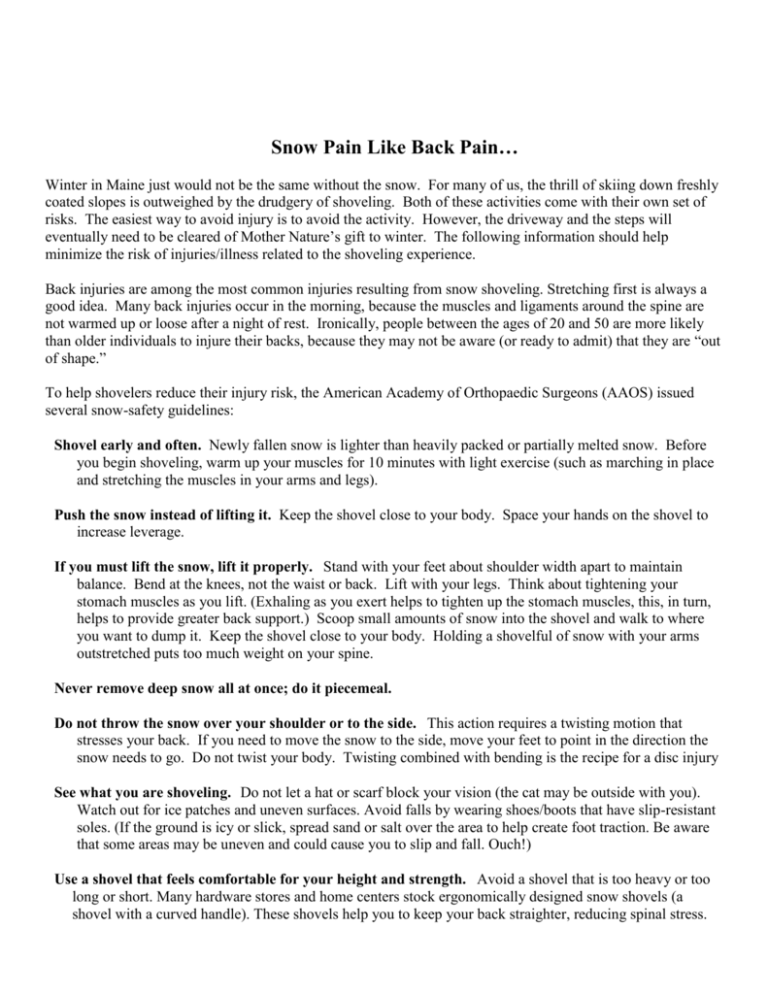To help shovelers reduce their injury risk, the American Academy of
advertisement

Snow Pain Like Back Pain… Winter in Maine just would not be the same without the snow. For many of us, the thrill of skiing down freshly coated slopes is outweighed by the drudgery of shoveling. Both of these activities come with their own set of risks. The easiest way to avoid injury is to avoid the activity. However, the driveway and the steps will eventually need to be cleared of Mother Nature’s gift to winter. The following information should help minimize the risk of injuries/illness related to the shoveling experience. Back injuries are among the most common injuries resulting from snow shoveling. Stretching first is always a good idea. Many back injuries occur in the morning, because the muscles and ligaments around the spine are not warmed up or loose after a night of rest. Ironically, people between the ages of 20 and 50 are more likely than older individuals to injure their backs, because they may not be aware (or ready to admit) that they are “out of shape.” To help shovelers reduce their injury risk, the American Academy of Orthopaedic Surgeons (AAOS) issued several snow-safety guidelines: Shovel early and often. Newly fallen snow is lighter than heavily packed or partially melted snow. Before you begin shoveling, warm up your muscles for 10 minutes with light exercise (such as marching in place and stretching the muscles in your arms and legs). Push the snow instead of lifting it. Keep the shovel close to your body. Space your hands on the shovel to increase leverage. If you must lift the snow, lift it properly. Stand with your feet about shoulder width apart to maintain balance. Bend at the knees, not the waist or back. Lift with your legs. Think about tightening your stomach muscles as you lift. (Exhaling as you exert helps to tighten up the stomach muscles, this, in turn, helps to provide greater back support.) Scoop small amounts of snow into the shovel and walk to where you want to dump it. Keep the shovel close to your body. Holding a shovelful of snow with your arms outstretched puts too much weight on your spine. Never remove deep snow all at once; do it piecemeal. Do not throw the snow over your shoulder or to the side. This action requires a twisting motion that stresses your back. If you need to move the snow to the side, move your feet to point in the direction the snow needs to go. Do not twist your body. Twisting combined with bending is the recipe for a disc injury See what you are shoveling. Do not let a hat or scarf block your vision (the cat may be outside with you). Watch out for ice patches and uneven surfaces. Avoid falls by wearing shoes/boots that have slip-resistant soles. (If the ground is icy or slick, spread sand or salt over the area to help create foot traction. Be aware that some areas may be uneven and could cause you to slip and fall. Ouch!) Use a shovel that feels comfortable for your height and strength. Avoid a shovel that is too heavy or too long or short. Many hardware stores and home centers stock ergonomically designed snow shovels (a shovel with a curved handle). These shovels help you to keep your back straighter, reducing spinal stress. Also, a smaller shovel blade will require you to lift less snow, placing less strain on your muscles. Once you have your shovel, you might want to consider spraying a bit of silicon lubricant or WD-40 (for you trivia buffs, “Water Displacement, 40th attempt”) on the blade. This can help keep the snow from sticking to the shovel. Pace yourself. Begin shoveling slowly. (World-class runners do not start their races at full speed.) Take frequent breaks and drink plenty of water to prevent dehydration, which affects muscles. Most individuals are not aware of how much they perspire when they are outside, working in the cold. As a result, they do not drink sufficient water before, during, and after outdoor winter activity. Check with your doctor. If you have a medical condition or do not exercise regularly, talk with your doctor before shoveling. If necessary, hire someone to remove the snow. The potential for musculoskeletal injury is high among inexperienced snow-shovelers, as well as those who have shoveled so many times during the winter that they don't bother to think about snow safety. Beyond the Orthopedic Considerations: Be heart smart! Don’t eat or smoke before shoveling snow. Avoid caffeine before beginning. Caffeine and nicotine are stimulants and may increase heart rate and cause blood vessels to constrict. If you experience pain of any kind, stop immediately and seek assistance. Pace yourself, take frequent breaks to stretch your back and extremities. So, if I use a snow blower, I don’t have to worry about injuring myself, right? Not necessarily. A snow blower is a terrific piece of machinery but if not used correctly you can strain or injure your back. Snow blowers are designed to remove snow at a particular rate of speed. Pushing or forcing the equipment to go faster is defeating its purpose (to do the work for you!). Do you swing a chainsaw to fell a tree? Dressing for Maximum Comfort Consider the weather when choosing outerwear. Dress in layers. An effective layering system is made up of layers of components that work together to prevent you from becoming wet from your own sweat and/or precipitation. Such a system is made up of three basic layers: long underwear, insulation and the outer shell. The thermal underwear layer should keep moisture away from the skin and preserve a critical layer of dry air between the skin and clothing. Underwear made of synthetic materials like CoolMax, Supplex/Lycra®, or polypropylene are superior to their predecessors, wool and cotton, because they literally wick perspiration away from your skin allowing it to pass to outer layers where evaporation can occur. The thermal layer stays dry and you remain comfortable. The insulating layer should be one that can readily be ventilated, put on or taken off easily and provide thickness without being too dense or heavy. Garments made of fleece or pile are a good choice for the middle layer and will allow your perspiration to pass through the layers. The outer layer is often called a shell because its purpose is to shield your under layers from the wind, rain and snow. The shell should allow perspiration to escape to the atmosphere. It could be a vest, jacket, or a complete water or wind proof outfit. In addition to layering for maximum warmth/comfort, it is also important to maintain warmth of the head and extremities. Wear a hat - a great deal of body heat is lost through the head. If icy cold, consider breathing through a scarf but don’t let it obstruct your view. Proper boots are essential for keeping feet warm and dry. Choose gloves that will keep your hands warm, dry and blister free - consider thicker gloves allowing for a good grip on the shovel’s handle.







